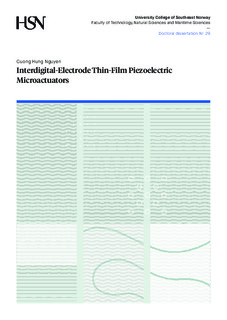| dc.contributor.author | Nguyen, Cuong Hung | |
| dc.date.accessioned | 2018-01-23T14:02:23Z | |
| dc.date.available | 2018-01-23T14:02:23Z | |
| dc.date.issued | 2018-01 | |
| dc.identifier.isbn | 978-82-7860-311-6 | |
| dc.identifier.issn | 2464-2843 | |
| dc.identifier.uri | http://hdl.handle.net/11250/2479145 | |
| dc.description.abstract | Along with microsensors, microactuators are the most important components of microelectromechanical systems. Many microactuators use piezoelectric coupling mechanisms because they allow these actuators to generate high levels of force to perform fast switching with low power consumption. Two different coupling are typically used to drive microactuators: the d31-transversal and d33-longitudinal cou-plings. In practice, a specific coupling is selected through the electrode configuration used in the actuator design, where a top and bottom electrode (TBE) configuration is used for the d31 coupling and an interdigitated electrode (IDE) configuration is used for the d33 coupling.
Simple considerations indicate that the longitudinal piezoelectric effect is expected to be twice as strong as the transverse effect because the piezoelectric coupling constant d33 has a value that is approximately double that of the d31 constant for most piezoceramics. However, because of the effects of inhomogeneous electric fields and passive regions that cannot be actuated, the performance of IDE actuators can be worse than that of the TBE type and is difficult to predict. In addition, publications in the literature on the d33 coupling are relatively scarce when compared with those on the d31 coupling. Therefore, there is a need for greater understanding of the properties of IDE actuators. This thesis thus focuses on the modelling, simulation and characterization of piezoelectric actuators using the IDE configuration. Both beam- and plate-type microactuators are investigated.
Using the linear constitutive relationship of piezoelectricity as a starting point, bending models of these actuators are first established, and a new governing equation is derived for the bending of the beam-type actuator. This governing equation leads to the establishment of a linear two-port model for the transducer. This model of the two-port parameters helps us to understand the effects of the materials electromechanical coupling factor on the transducer’s electrical properties, e.g., its capacitance, and its mechanical properties, e.g., stiffness and flexural rigidity. The most challenging aspect of modelling of the IDE transducer is the inhomogeneous electric field. Unlike the case of a normal dielectric without piezoelectricity, the Laplace equation cannot be applied directly to solve for the electric field in this case because the mechanical stress has an additional effect on the electric field. However, if the piezoelectric layer is thin, certain simplifications can be made. We therefore establish suitable models of both the inhomogeneous electric field and the free capacitance. These new models are then used to characterize a thin ferroelectric material. When compared with the current state-of-art characterization methods, more consistent curves are obtained for the ferroelectric material’s properties, such as the CV and PV and the stress-field loops. Additionally, we found that while the permittivity of the ferroelectric material is dependent on the electric field, the permittivity distribution can be treated homogeneously.
Finally, circular plate actuators with different electrode configurations, including top and bottom, interdigitated, spiral, and radial electrodes, are investigated. A comparison of the deflection properties of these different electrode configurations is presented and the IDE and TBE actuators are shown to be the best in terms of bending. In an equal-voltage comparison, the IDE actuators are deflected less than the TBE actuators because of their inhomogeneous electric fields. However, in an equal-field comparison, the IDE actuators can produce higher deflections than the TBE actuators. | nb_NO |
| dc.language.iso | eng | nb_NO |
| dc.publisher | University College of Southeast Norway | nb_NO |
| dc.relation.ispartofseries | Doctoral dissertations at the University College of Southeast Norway;29 | |
| dc.relation.haspart | Article 1: Cuong H. Nguyen, Ulrik Hanke, Einar Halvorsen, Actuation of Piezoelectric Layered Beams with d31 and d33 Coupling, accepted, IEEE Transactions on Ultrasonics, Ferroelectrics, and Frequency Control. | nb_NO |
| dc.relation.haspart | Article 2: Cuong H. Nguyen, Ulrik Hanke, Einar Halvorsen, The Constitutive Equations of Piezoelectric Layered Beams with Interdigitated Electrodes, under review. | nb_NO |
| dc.relation.haspart | Article 3: Cuong H. Nguyen, Robin Nigon, Trygve Raeder, Ulrik Hanke, Einar Halvorsen, Paul Muralt, Probing-models for interdigitated electrode systems with ferroelectric thin films, under review. | nb_NO |
| dc.relation.haspart | Article 4: Cuong H. Nguyen, Mahmoud A. Farghaly, Muhammad N. Akram, Ulrik Hanke, Einar Halvorsen, Electrode configurations for layered-plate piezoelectric micro-actuators, In Microelectronic Engineering, Volume 174, 2017, Pages 59-63, ISSN 0167-9317. | nb_NO |
| dc.relation.haspart | Article 5: Cuong H. Nguyen, Ulrik Hanke, Einar Halvorsen, Comparison of microactuators based on piezoelectric layered plates with d31 and d33 coupling, Active and Passive Smart Structures and Integrated Systems 2016, Proc. of SPIE Vol. 9799, 97991C. | nb_NO |
| dc.title | Interdigital-Electrode Thin-Film Piezoelectric Microactuators | nb_NO |
| dc.type | Doctoral thesis | nb_NO |
| dc.subject.nsi | VDP::Teknologi: 500::Nanoteknologi: 630 | nb_NO |
| dc.source.pagenumber | 110 | nb_NO |
